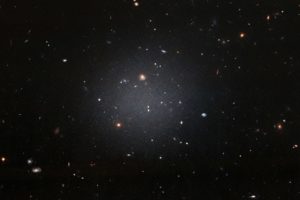When Dark Matter Goes Dark: New Research Suggests There May Be More than One Way to Form a Galaxy
 Diffuse galaxy NGC 1052-DF2 (NASA, ESA, and P. van Dokkum)
Diffuse galaxy NGC 1052-DF2 (NASA, ESA, and P. van Dokkum) There’s a lot of mystery surrounding the theory of dark matter. Although it’s thought to make up 27 percent of the universe, it is extremely difficult to detect as its presence is implied through gravitational effects. Dark matter is theorized to be the foundation upon which all galaxies are formed, but a new study just might be turning that theory on its head, and more.
In the study published last week in Nature, a team of astrophysicists uncovered the first galaxy in our knowledge to be substantially lacking dark matter. “We thought that every galaxy had dark matter and that dark matter is how a galaxy begins,” lead researcher and Yale astrophysicist Pieter van Dokkum said in a press release. “There is no theory that predicted these types of galaxies. The galaxy is a complete mystery, as everything about it is strange. How you actually go about forming one of these things is completely unknown.”
The 10 billion-year-old galaxy, called NGC 1052-DF2, is ultra-diffuse, meaning that it has a faint appearance and contains 200 times fewer stars than our own Milky Way galaxy. Although ultra-diffuse galaxies are not uncommon, all of the ones we’ve uncovered so far (with the exception of NGC 1052-DF2) display the effects of dark matter. “If there is any dark matter at all, it’s very little,” van Dokkum described. “The stars in the galaxy can account for all the mass, and there doesn’t seem to be any room for dark matter.” Researchers believe that this galaxy, which resides about 65 million light-years away, could be key in figuring out if galaxies can form in more than one way. This finding also challenges theories that attempt to disprove dark matter and may lead astrophysicists one step closer to proving the existence of dark matter.
One alternative hypothesis to dark matter is Modified Newtonian Dynamics, or MOND. It presents a modified law of gravity in an attempt to explain the gravitational inconsistencies observed in the movement of some galaxies. Although MOND has seen some success, like when it was used to predict the motions of ten dwarf galaxies, it is doubted by many astrophysicists. Yotam Cohen, a graduate student at Yale and co-author of the newly released study, explained that their findings significantly challenge MOND:
In MOND, the extra gravitational forces observed on galactic scales are woven into the equations, meaning that wherever you see galaxies, you should see the effect of the modified gravity. However, in this galaxy, there is no need for the extra gravity to explain its kinematics. In other words, this suggests that galaxies and dark matter are separable components and, by extension, that dark matter is a material substance, which is the opinion of the majority of professional astronomers.
But there’s still lot more work to do. In the nature of scientific integrity, researchers now must look for and analyze other galaxies that are similar to NGC 1052-DF2 in order to see if their findings are replicated elsewhere. And the results could be significant. “This invisible, mysterious substance is the most dominant aspect of any galaxy. So finding a galaxy without it is unexpected,” Dokkum explained. “It challenges the standard ideas of how we think galaxies work, and it shows that dark matter is real: it has its own separate existence apart from other components of galaxies. This result also suggests that there may be more than one way to form a galaxy.”
This study serves as a reminder that we have a long way to go in understanding our universe. Dark matter still remains a mystery, but now we have more material to frame our discussions and research. We must always remember the importance of confronting observations that challenge our pre-existing theories; discovery or failure—you never know what they might reveal.
